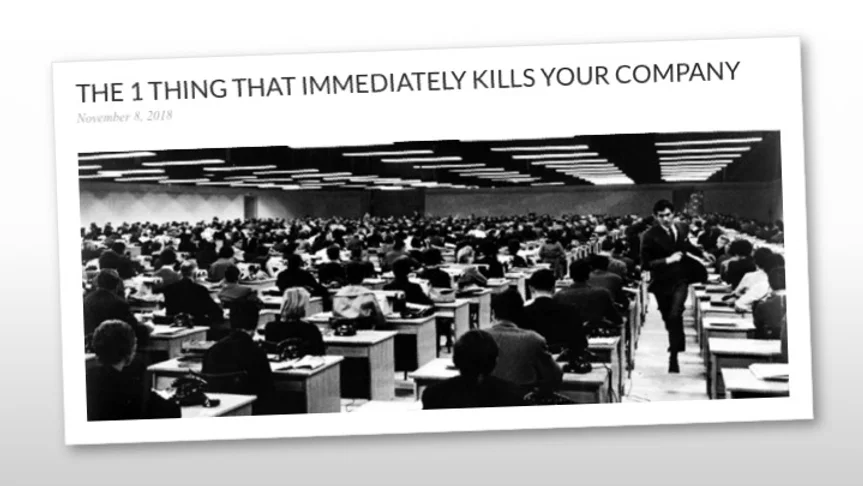Awesome and strong article about “bureaucracy”. The Corporate Rebels refer to Gary Hamel’s data showing that large companies have become even more conservative; based on the BMI (Bureaucracy Mass Index); HBR, August 10, 2017. Gary Hamel and Michele Zanini are calling bureaucracy the enemy of speed. I would like to add “of agility”.
“Bureaucracy must die!” shouted Gary Hamel from the stage of the 2nd RenDanHeYi Forum in China recently.
This influential guru is on a mission to rid organizations of bureaucracy. As Corporate Rebels, we strongly support his campaign. It is urgently needed. Why? Because bureaucracy in large organizations is growing, not shrinking. This, despite all the recent talk about fads like ‘Teal’ and ‘Holacracy’.
Gary and his co-worker Michele Zanini have shown that most large organizations have 8 or more layers of management. That’s 8 or more! What the hell are they all for?
THE $9 TRILLION BUREAUCRACY TRAP
Hamel’s data shows that large companies have become even more conservative, more rule-bound and more centralized. This is untenable. It’s a waste of resources, and just plain bullshit. For too long now we have built organizations on toxic processes that add no real value to society—but cost heaps.
And this isn’t just small change. It costs us a crazy amount of money! According to research from Hamel, Zanini, and coworkers, excess bureaucracy costs the US, alone, $3 trillion per year. They recently estimated the figure to be around $9 trillion for the OECD countries. That’s a 9 with 12 zero’s!
REMOVING THE ‘UNINSTALLABLE’
These insights confirm that most of us endure useless bureaucracy on a daily basis. In some way, it infects the organizations we all work in or depend on. Despite these enormous costs, it’s still the default operating system for large organizations. And it is still regarded widely as basic, simple and scalable.
But this is not true now, if it ever was. Today, bureaucracy looms as a dangerous liability. As Gary puts it: “The world is becoming more turbulent faster than organisations are becoming more resilient.”
FROM BUREAUCRACY TO HUMANOCRACY
But the uninstall button is hard to find. There is no simple process to remove bureaucracy. Indeed, Gary advocates a gradual transition from bureaucracy to what he calls ‘humanocracy’. The concept of humanocracy is based on the best practices of progressive workplaces we are more than familiar with.
Among these are Bucket List organizations like Haier, Morning Star, Handelsbanken, W.L. Gore and Spotify. They have all proven capable of running large and complex organizations with lean management practices and a minimum of bureaucracy.
10 POINTERS OF HUMANOCRACY
Some have decades of experience, which gives them significant business advantage. They show the rest of us how to ditch excess bureaucracy. They inspire Gary’s 10 distinguishing characteristics of humanocracies:
Everyone acts like an ownerOperating units are small (<50 individuals)Leaders are chosen by the ledThere are no internal monopoliesControl comes from ‘around’ not ‘above’Tasks are chosen, not assignedCoordination is the product of collaborationDecisions reflect the wisdom of the crowdOrganizational boundaries are seamlessEveryone reports to the customer
ROLLING OUT CHANGE IS BULLSHIT
We are pleased to see these 10 characteristics align well with our 8 habits of highly progressive workplaces. Organizations can draw inspiration from this cluster of principles and processes. Those that do will enjoy the advantages of scale without falling into the trap of building inherently toxic structures.
But how can traditional organizations reinvent themselves? How can they transform towards a humanocracy? How can they effectively end bureaucracy? These million dollar questions beg answers.
Gary doesn’t advocate a ‘big-bang’ approach—that is, layering on a new model with a set of pre-fixed practices. There is no single model or solution. The idea of a fixed solution is bullshit. Worse, it is more likely to provoke backslash than progress.
AN ENORMOUS VARIATION OF BEST-PRACTICES
Most progressive organization do not share a specific set of best practices. They vary widely. This is the most important argument against starting change with a fixed solution.
“It is not about the particular practices, but rather about the principles on which they are based.” Practices will vary over time. Instead, start your transformation with a defining a set of principles. Practices will emerge, and they might be inspired by other progressive workplaces.
REVOLUTION & EVOLUTION
Gary believes transformations emerge from continuing experiments. “Experiments that should be revolutionary in intent, but evolutionary in practice.” Instead of implementing a fixed model, create and sustain a process of ‘discovery’.
Organizations can support this by encouraging people to select their own experiments, in a crowd-sourcing way. They should have the freedom to try out new ideas. That gives them a real voice in developing their‘organization of the future’.
Only then bureaucracy might end.





